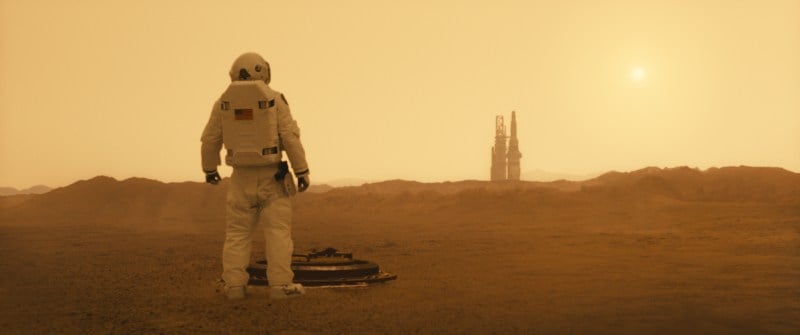James Gray’s “Ad Astra” puts Brad Pitt in space, with a pleasant and dichotomously different character portrayal than his role in “Once Upon a Time in Hollywood.” It’s perhaps the most satisfying space-themed film I’ve seen in a while, but it’s not without its flaws.
Roy McBride (Pitt) is told that his long-lost astronaut father may still be alive in space near Neptune, and he’s quickly shuttled to Mars to attempt to deliver a message. However, the true purpose behind this entire project is hidden by the U.S. Space Command (essentially a militarized NASA), and suddenly Roy is spurred on by the burning need to talk to his father one last time before the organization can blow up his father’s Neptune-adjacent space residence. Once this door is opened, there’s no turning back: Roy is on a mission and nothing — or, rather, no one — will get in his way.
“Ad Astra” is less of a film about space exploration and more of a character study that just happens to be about an astronaut seeking his father. But, of course, because it’s set in the future (and in space), it’s complemented by the science fiction label (everything is now compared to “Interstellar”). Or perhaps in this case, as much as I hate to say it, it’s instead weighed down by this genre label. As a big fan of science fiction, I came into the film with expectations for what it might choose to depict, some of which were fulfilled and exceeded, some of which were never quite reached.
I’ll admit that I was visually stunned by “Interstellar.” When I watched it back in 2014, I was so glad I saw it in theaters — the sheer awe that came with seeing those scenes of space travel and images crafted to be beyond our perceivable dimensions and human experience was unbelievable.
Gray and cinematographer Hoyte van Hoytema craft something similar in “Ad Astra,” especially towards the beginning of the film — moments where you feel like you’re falling, spiraling dizzyingly but satisfyingly inwards and into another realm (but also a content warning to those affected by that onscreen!). As the film went on and became more and more still, I yearned for more of that magical quality that transports the viewer beyond their seat.
Like a lot of speculative literature (maybe more so than popular film), “Ad Astra” heavily incorporates introspective themes and even religious imagery (look out for “The Creation of Adam” references). Somewhere along the way, you might begin to question what you’re seeing onscreen: what’s actually taking place and what’s merely an extension of Roy’s desires. “Ad Astra” is a compelling tale of redemption and clarity of conscience — but, of course, not without consequences for Roy. In many ways, “Ad Astra” seems to portray the message that men simply aren’t satisfied with their romantic and social lives until they reconcile, imaginarily or not, with their fathers (oops, did I say that?).
And yet, beyond being contemplative, “Ad Astra” also wants to thrill you. For the most part, it succeeds, complete with a Mars rover “space pirates” car chase scene and a research-animal-gone-rogue attack scene that feel more like inspirations from the “Fast and Furious” and “Jurassic Park” franchises than space films. For some, they understandably might feel out of place, but Gray’s adaptations of these classic cinema tropes slide smoothly into the film not merely as bits of adventure, but also as integrated harbingers of what terrors the future of space exploration and beyond-Earth expansion might bring.
For the most part, “Ad Astra” is meditative, haunting and beautiful — but for me, there’s a piece missing. A welcome but puzzling brief appearance by Ruth Negga (who has cemented her place in sci-fi/fantasy media with roles in “Preacher” and “Agents of S.H.I.E.L.D.”) is a perfect metonym for this.The character dumps a lot of information on viewers in one crucial scene, and there seems to be some kind of genuine connection between her and Roy and their stories, but in a flash, she’s gone.
Furthermore, we’re only provided with glimpses of Roy’s memories of his separated wife and brief narrations of Roy’s toxic relationship with his work- and self-obsessed father. We’re never given the satisfaction of an extended backstory — in any form, really — with any people who were ever important in Roy’s life. Admittedly, that’s part of the point — Roy is distant and currently sustains no real connections with others in his life. Yet, “Ad Astra” eventually falls short on this front because without any audience attachments to Roy’s relationships, we’re unable to fully empathize with Roy’s relentless mission.
Lastly, it’s worth noting that “Ad Astra” somewhat wastes its star-studded cast. The film features Tommy Lee Jones as Roy’s father, Donald Sutherland as a colonel accompanying Roy, Liv Tyler as Roy’s estranged wife and even a bizarre near-cameo by Natasha Lyonne. Yet, given how weak Roy’s connections are with others, each of the characters spends just enough time for viewers to recognize their face onscreen and acknowledge the cast, but not enough to really utilize their performance potential. Sutherland especially spends a disappointing amount of time onscreen, and I can’t even recall if Tyler talks at all in the film. And despite the cast and $80-100 million budget, the film also doesn’t seek to impress you with the gall of its depiction of futuristic technology (for better or for worse). The most amusing and perhaps realistic things we really get are the Yoshinoya/Applebee’s/other chain logos shining like little stars from the Moon’s commercial airport/spaceship port (“Welcome to the Moon!”).
Even the Moon has been overrun by capitalism. If there was ever a hidden message amidst Brad Pitt’s space mission for enlightenment and self-discovery, maybe it’s that.
Contact Olivia Popp at oliviapopp ‘at’ stanford.edu.
